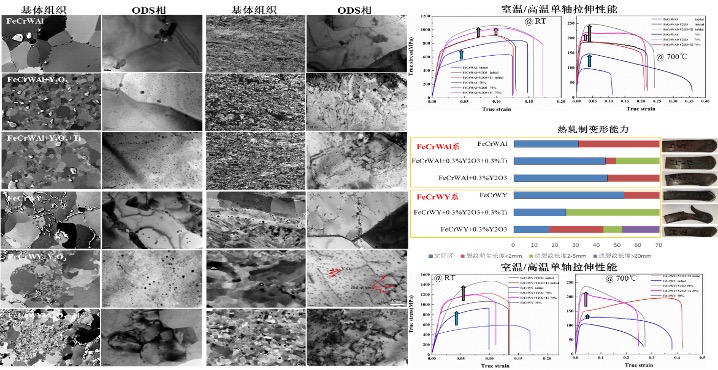Microstructure and Mechanical Properties
of the FeCrW Series ODS Steel Produced by A High-throughput Preparation Method
Jinru Luo*, Pei He*, Changhao Wang,
Pengcheng Zhang
Institute of Material, China
Academy of Engineering Physics, Mianyang, 621908
ABSTRACT: The new generation
advanced nuclear reactor and controlled fusion have been considered as the one
of the most important components of the future energy. Obtaining higher thermal
efficiency with more secure guarantee is the main development objective of the
new generation nuclear energy. Therefore, the structural material has been to
facing the tough challenge that must be working under the extreme conditions of
high temperature, irradiation, corrosion and the coupled stress, which makes
the structural material designed for the coming nuclear reactor has to have
perfect comprehensive performance. Oxide dispersion strengthened (ODS) ferritic
steel has been considered as one of the most promising candidates of the fuel
cladding materials for the fission reactors and structural blanket materials for
the fusion reactors of the coming new generation because of its outstanding
performance under the neutron exposure, helium atmosphere, and reactor coolant.
A FeCrW series ODS-steel has been developed in the present study on the base of
Fe13.5CrWAl and Fe13.5CrWY alloys adding Y2O3 or Y2O3 and Ti. Sheet samples of
multi-component on gradient deformation strain level have been prepared by
synchronous hot isostatic sintering (HIP) and wedge hot rolling. The
distribution of Y-rich dispersed phase in the samples is uniform and the
density of the HIPed initial sheet is close to 100% measuring by Archimedes
method. The characterization technique of XRD, ECC, EBSD and SANS have been
applied to analyze the phase composition, sub-structure of the matrix alloy,
and the chemical composition, structure, size and density distribution of the
ODS phase. Uni-axial tensile tests at the ambient and high temperature of 700 °C
have been carried on to discuss the mechanical properties of rolled samples.
The results indicate that the addition of Al element can coarsen both the
matrix grains and ODS phase. And the formability of the sheet in this series is
higher. All the samples on different strain level are ferrite. The Y addition
pre-alloying samples have smaller ODS particles which successfully obtained by
means of internal oxidation, and leads to a higher room temperature and high
temperature mechanical properties of the sheet. Y added samples are more likely
to undergo martensitic transformation during deformation. Therefore the matrix
grains suffered martensitic transformation at a certain strain level and makes
the rolled sheets have duplex structure of ferrite and martensite. Comparing
with the samples without ODS particles, the mechanical properties of samples
can be significantly improved by nearly 100 MPa. The hot rolling deformation at
the strain of 70% can effectively break the carbide inclusions in, and the
matrix grain refinement effect is remarkable without obvious coarsening of the
ODS phase. Finally, a ODS-steel sheet sample with the strength as high as 1.5
GPa at room temperature and the high temperature strength nearly 250 MPa at 700
℃ can be obtained without significant
plasticity lose.

Keywords: ODS steel; hot isostatic pressing; wedge rolling; microstructure; high temperature strength

Luo Jinru, female, is an associate researcher at the Institute of Materials Research, China Academy of Engineering Physics, and who is born in April 1984 in Jingzhou, Hubei, Ph.D. in Materials Science and Engineering from Tsinghua University. She has served as a lecturer at Harbin Institute of Technology, a postdoctoral fellow both at the University of British Columbia in Canada and Chaoke River National Laboratory, and a lecturer at the State Key Laboratory of New Metal Materials at the University of Science and Technology Beijing. Mainly engaged in the research of the microstructure of metal materials. As the project leader, she presided over a number of scientific research projects such as the National Natural Science Foundation Youth Fund and the Chinese Academy of Sciences’ Capability Enhancement Key Project; as the main participant, he participated in the key research and development plan of the Ministry of Science and Technology, the Canadian Government Strategic Joint Fund, 973/ 863 , international cooperation of the Ministry of Science and Technology, totally more than ten scientific research projects, published more than 30 SCI journal papers in academic journals such as Acta Materialia in the past five years. He is currently a director of the Sichuan Electron Microscopy Society and a member of the Sichuan Nuclear Fusion and Low Temperature Plasma Physics Committee.